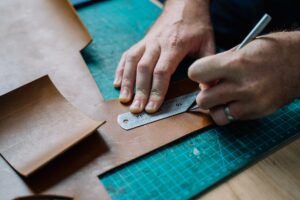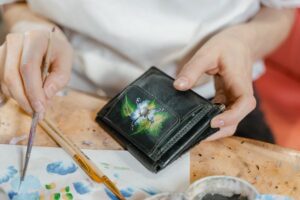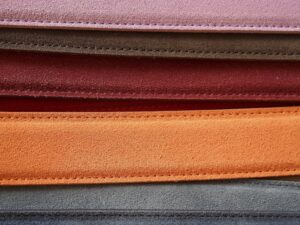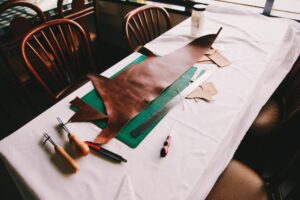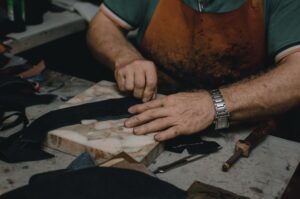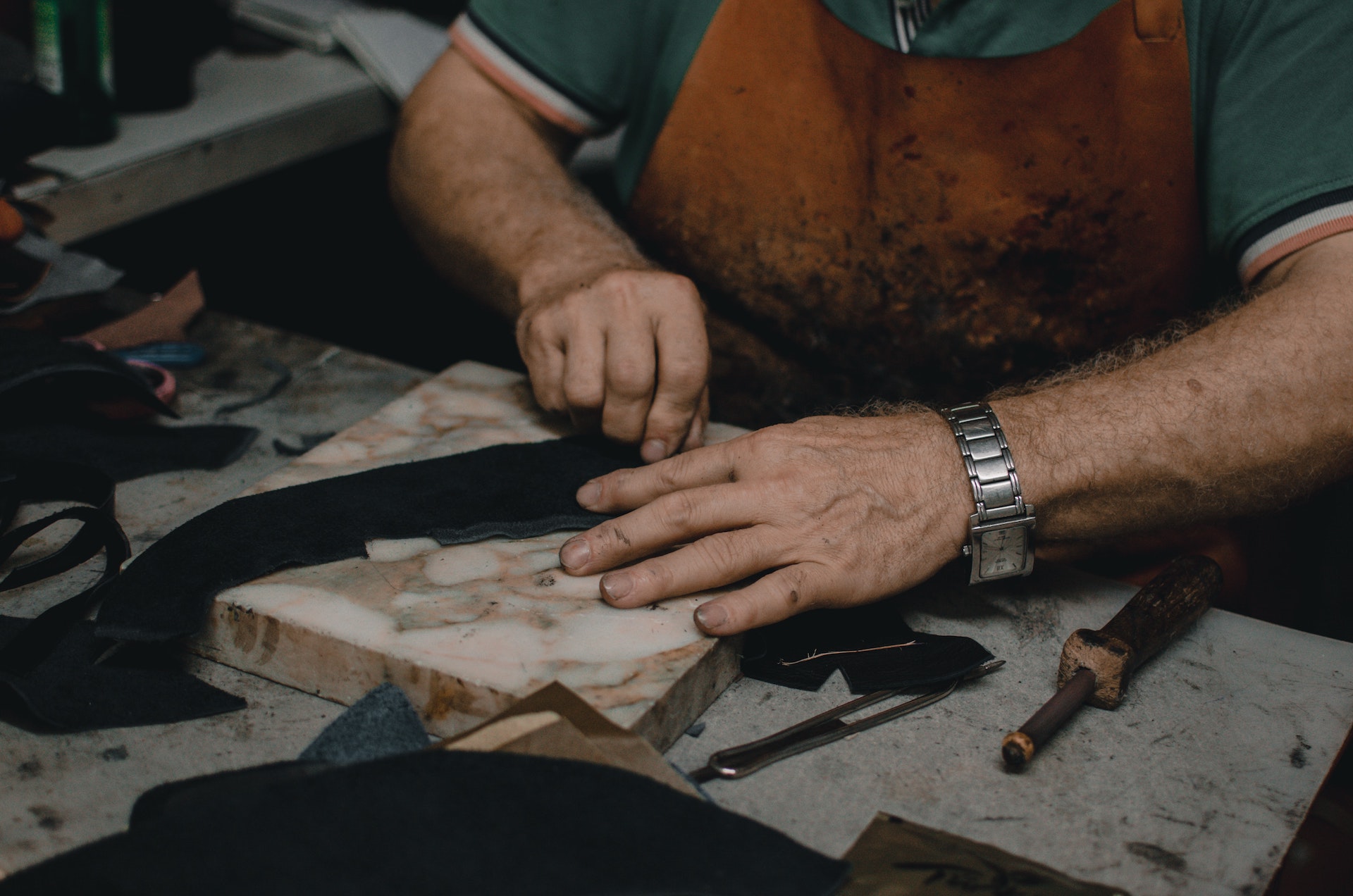
Leathercraft is the art of working with leather to create a variety of items, including belts, wallets, bags, and even furniture. To be successful in leathercraft, it is important to have the right tools on hand. In this article, we will explore some of the most common and essential leathercraft tools and discuss how they are used in the leatherworking process.
6 Tools You Need for Leatherwork
1. Cutting Tools
One of the first steps in any leathercraft project is cutting the leather to the desired size and shape. For this, you will need a good pair of scissors, a rotary cutter, or a leather shears. Scissors are useful for cutting straight lines, while rotary cutters are great for curves and circles. Leather shears, on the other hand, are specifically designed for cutting leather and have longer blades than regular scissors, which makes them easier to use on thicker pieces of leather.
Scissors: There are a few different types of scissors that can be used for leathercraft. Standard scissors can be used for cutting straight lines, but they may not be as effective on thicker pieces of leather. Pinking shears have serrated edges that can help prevent the leather from fraying, while curved scissors have a curved blade that can make it easier to cut curves and circles.
Rotary cutter: A rotary cutter is a circular blade mounted on a handle that is used to cut fabric, paper, and other materials. In leathercraft, a rotary cutter can be used to cut straight or curved lines, as well as circles. Rotary cutters are particularly useful for cutting multiple layers of leather at once and can be used in conjunction with a cutting mat to help protect the surface of your worktable.
Leather shears: Leather shears are scissors that are specifically designed for cutting leather. They have longer blades than regular scissors and are often made of a stronger, more durable material. Leather shears can be used to cut straight lines or curves and can easily handle thicker pieces of leather.
2. Stamping tools
Stamping tools are used to emboss designs and patterns onto the leather surface. These tools come in a variety of shapes and sizes and can be used to create intricate designs or simple, bold lines. Common stamping tools include leather stamps, swivel knives, and bevelers.
Leather stamps: Leather stamps are metal tools with a design or pattern on one end that is used to emboss the leather. There are a wide variety of leather stamps available, ranging from simple shapes and lines to intricate designs and patterns. Leather stamps can be used with a mallet to apply pressure and create a deeper impression on the leather.
Swivel knives: A swivel knife is a hand-held tool with a blade that rotates on a pivot point. It is used to cut and carve leather, as well as create freehand designs and patterns. Swivel knives are particularly useful for creating curved lines and intricate details.
Bevelers: Bevelers are tools with a flat, chisel-like blade that is used to create a beveled edge on the leather. Bevelers can be used to add a decorative edge to a piece of leather or to smooth out rough edges.
3. Punching tools
Punching tools are used to create holes in leather for lacing or stitching. The most common punching tool is the leather punch, which comes in a variety of sizes to accommodate different thicknesses of leather. Other punching tools include chisels, punches, and pricking irons, which are used to create precise holes for stitching.
Leather punch: A leather punch is a tool with a handle and a series of interchangeable punch heads that are used to create holes in leather. The punch heads come in a range of sizes to accommodate different thicknesses of leather. Leather punches are usually used in conjunction with a mallet to apply enough force to punch through the leather.
Chisels: Chisels are similar to bevelers but have a sharper, more pointed blade. They are used to create precise, clean-cut holes in leather for stitching or lacing.
Punches: Punches are similar to chisels but have a more rounded blade. They are used to create slightly larger holes in leather for stitching or lacing.
Pricking irons: Pricking irons are thin, needle-like tools with a pointed tip that are used to create precise holes in leather for stitching. They come in a variety of sizes to accommodate different thicknesses of leather.
4. Stitching tools
Stitching is an important aspect of leathercraft and requires a few specific tools. A leather needle is a long, thin needle with a large eye that is designed for use with leather. You will also need a spool of waxed thread, which is stronger and more durable than regular thread and helps the needle glide smoothly through the leather. A stitching pony or a clamp is also helpful for holding the leather in place while you work.
Leather needle: A leather needle is a long, thin needle with a large eye that is designed for use with leather. Leather needles are stronger and thicker than regular sewing needles and are able to handle the thicker, more durable thread used in leatherworking.
Waxed thread: Waxed thread is a strong, durable thread that is coated in wax to help it glide smoothly through the leather. It is essential for leather stitching and is available in
5. Edging tools
Edging tools are used to smooth and finish the edges of leather. An edge beveler is a tool with a rounded blade that is used to smooth and round the edges of the leather. An edge slicker is a flat, rectangular tool with a smooth surface that is used to burnish and polish the edges of the leather.
Edge beveler: An edge beveler is a tool with a rounded blade that is used to smooth and round the edges of leather. Edge bevelers come in a variety of sizes to accommodate different thicknesses of leather and can be used to create a decorative edge or to smooth out rough edges.
Edge slicker: An edge slicker is a flat, rectangular tool with a smooth surface that is used to burnish and polish the edges of leather. Edge slicks are typically made of a hard, polished material such as agate or bone and are used to smooth and shine the edges of the leather.
6. Finishing tools
After you have completed your leathercraft project, you may want to apply a finish to protect the leather and give it a polished look. A leather conditioner or a leather oil can be used to nourish and moisturize the leather, while a leather protector can help to prevent stains and water damage. A leather dye can also be used to change the color of the leather or to cover up imperfections.
Leather conditioner: Leather conditioner is a product that is used to nourish and moisturize leather to help prevent it from drying out and cracking. Leather conditioner is typically made of a combination of oils and waxes and is applied to the leather with a soft cloth.
Leather oil: Leather oil is a product that is used to moisturize and protect leather. It is typically made of a combination of oils and waxes and is applied to the leather with a soft cloth. Leather oil can help to restore the natural shine of the leather and prevent it from drying out and cracking.
Leather protector: Leather protector is a product that is used to protect leather from stains and water damage. It is typically applied to the leather with a soft cloth and forms a protective barrier on the surface of the leather.
Leather dye: Leather dye is a product that is used to change the color of leather or to cover up imperfections. Leather dye is available in a wide range of colors and is typically applied to the leather with a brush or sponge. It is important to test the dye on a small, inconspicuous area of the leather before applying it to the entire piece to ensure that you are happy with the color.
Leathercraft is a rewarding and satisfying hobby that requires a variety of tools. From cutting tools to stitching tools and finishing tools, having the right tools on hand can make all the difference in the quality of your finished project. Whether you are a beginner or an experienced leatherworker, it is worth investing in a good set of leathercraft tools to help you create beautiful and durable leather items.

